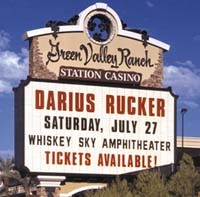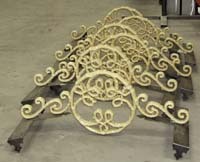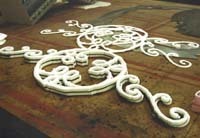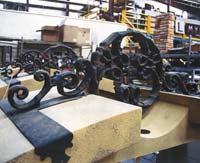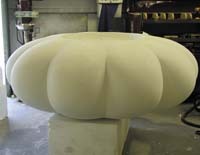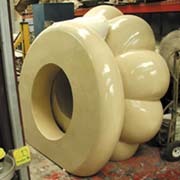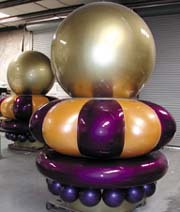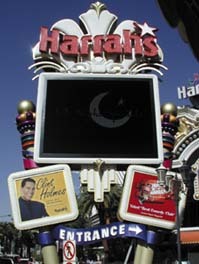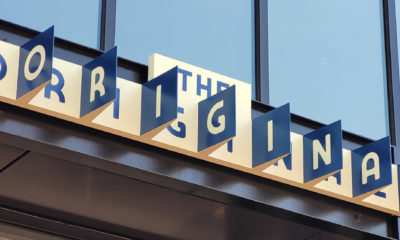Dimensional Signs
Fantasy by Demand
Foam, fiberglass and faux painting add extra dimensions to signage.
Published
18 years agoon
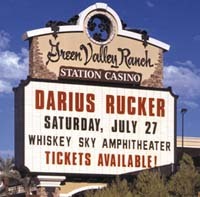
When is a sign more than a sign? When it includes sculpture, statues and scroll work. These added edges to signage, known as theming, proliferate in Las Vegas, where themes dictate how hotels and casinos — and thus the signs — are designed.
The local branch of Young Electric Sign Co. (YESCO) has provided Las Vegas with signage ranging from wayfinding to spectaculars. The company places so much importance on theming that it has dedicated a department to it.
"Theming helps beautify or add another dimension to the creation of elegant and spectacular sign projects," says Eric Hutcheson, YESCO’s theming manager.
For the past 20 years, Hutcheson has been in the "theming" business. He was previously involved with architectural theming, in which "we took ordinary buildings and made them extraordinary" by adding such architectural ornamentation as cornices, capitals, columns and moldings.
Hutcheson has seen an interest in theme ornamentation migrate from building design to sign components. He says, "Sign theming doesn’t always have to be gaudy or fantasy-based enhancements. It can be as easy as the addition of some simple molding around the perimeter of the sign."
According to Hutcheson, every sign doesn’t require a themed element, but many can be enhanced with a sculptured flourish or flower-like ornament. When that opportunity arises, sign designers will add a "themed garnish."
After a sign design, which includes the theming element, is sold, it’s usually large enough that it’s broken into smaller pieces, which are fabricated and reassembled somewhat like a jigsaw puzzle.
Material choice
Themed enhancements typically comprise expanded polystyrene (EPS) and extruded foam (which can be sculpted by hand or a cutting machine), or urethane, polyester resin or fiberglass (which are molded).
Material choice is determined by production quantity — whether a few identical sign elements or multiples are produced. Hutcheson explains, "If, for example, we have a request for one or two pieces of statuary, it’s more economical to make the element from foam. If there’s a request for 50 identical statues, it’s a lot easier to sculpt a single master statue and make, via castings, the 50 or so extra copies we need."
The level of detail also determines the foam versus resin choice. Hutcheson says, "When you’re covering sculpted foam with a urethane hard coat, you lose some fine detail. If you have a request for a statue that shows off the hair, eyebrows and eyelashes, you switch from foam to a sculpted mold, which can provide fine detail."
Size and weight impact molded sign elements. Urethane or resin are appropriate for small pieces, whereas fiberglass suits such large projects as life-size statues. "Casting a statue in resin or urethane would make the piece too heavy," Hutcheson says.
Typically, a foam piece is first designed as a series of sketches, then a suitably sized foam block is sculpted by hand or with a computer-numerically-controlled (CNC) hot-wire rig or routing. Occasionally, the final creation may require all three methods.
If handsculpting is preferred, the basic sculptural image is penciled out on the foam. Then, various cutting tools massage and shape the final piece, which is, at that point, covered with a urethane coating and painted.
The scroll work is prepared in several steps:
The second approach incorporates a CNC hot-wire rig, which comprises a flatbed and motorized wire trolley (which works essentially like a taut piano wire) that’s suspended in front of the foam block. Operating from programmed computer specifications, the wire moves back and forth or up and down to sculpt the foam block.
The wire doesn’t even touch, much less cut, the foam. Instead, it’s the heat surrounding the wire. Temperatures ranging from 1,200° to 1,500°F create a "kerf," or cutting path. The piece is cut and separated from the foam block as a smooth, clean element, ready to be further processed, coated and painted.
Depending on the required foam shape, the theming shop may sculpt an element using a CNC router. Similarly programmed and set up like the hot-wire rig, the CNC router alternatively creates more 3-D shapes, such as bas relief, raised letters or inlaid moldings, that require a unique shape.
Regardless of the cutting method, the completed foam piece is spraycoated with a plural component, a two-part urethane that forms the final hard-coat finish. When the piece dries (usually within a minute), the surface is prepared with a specialized urethane primer, then painted with various coverings, ranging from automotive candy colors to a faux finish of stone, marble, wood or metal.
If a sculpted piece is molded, the sculpting process begins with a maquette, a miniature version of the final statue. Once the maquette passes review and is scaled up to size, the mold is formed, and the piece is cast in fiberglass or resin.
What’s your theme?
YESCO’s themed signs require a team effort that generally involves most, if not all, departments. The theming department translates the sign designs it receives from the art department and produces them to completion. Recent Las Vegas sign projects have included scroll work, statuary and fantasy forms, as reviewed in the following case histories.
Located in a Las Vegas suburb, the Green Valley Ranch hotel/casino was completed in 2002. This project’s signage emphasizes extensive theming based on curved, faux wrought iron, which Hutcheson describes as possessing "an old, metalsmith-pounded look."
Here are a few fabrication highlights:
To create this look, YESCO designer Jim Gietzen collaborated with the project’s owner, architect and designer to create a sign package that integrated faux-ornamental elements with the site’s unique architecture. Foam was cut with a CNC hot-wire rig, sculpted with the finishing detail, coated with a protective plural component and painted.
Hutcheson says, "We made a few dozen copies of this scroll work in varying sizes for all the Green Valley signage, from the scroll inserts on streetside pylons to wayfinding and garage-entrance signs."
In another project, a spectacular for Las Vegas’ Harrah’s hotel/casino, a decorative 77-ft.-high streetside pylon employed all the resources of YESCO’s design, theming and fabricating facilities. The pylon design was originated by YESCO designer Jim Gietzen.
Emblazoned across the sign’s massive, five-petal, fleur-de-lis insignia, the hotel’s name is spelled out in open channel letters. Directly below sit YESCO’s 24.6 x 31-ft., full-color, LED video display screen and, to the screen’s sides, a pair of jester-like, 46-ft., steel scepters, mounted at a slight diagonal to the video screen. A huge, double-sided, flexible-face display rests at the scepters’ midpoints.
A close examination of the scepter’s jester-like "cap" reveals the fabrication process for the pylon’s various 3-D elements — foam, fiberglass and acrylic — that form the eclectic, geometric "puzzle pieces."
The diagonal staff was created as a series of majestic, geometric forms butted and bolted together to crown the scepter. A huge, 5-ft.-diameter, fiberglass sphere, covered in pearlescent paint, sits atop the structure. The sphere was mounted with fasteners to a gore-shaped, handsculpted "jester collar," which was originally cut on a CNC hot-wire rig. The piece was then coated with urethane and painted in royal purple and yellow.
The collar and sphere were then glued to a huge disk, which was also cut from a CNC hot-wire rig. The foam disc was also urethane hardened and painted royal purple. Below the disk, a series of bluish-purple acrylic spheres was bolted to the bottom of the disk to become part of the scepter.
To attach the scepter to the foam and fiberglass assemblage, it was glued to a sheet-metal "top hat" and slipped over the shaft and secured with fasteners. The scepter shaft served as a mounting pole for the flexible-face displays hanging midway on each pole. The scepter cap’s geometric flourishes, the fleur-de-lis and frame moldings on the video and flexible-face displays were formed and finished in the theming shop.
Can smaller signshops utilize these techniques? Hutcheson says, "There’s always the expected capital expense of setting up a foam/fiberglass infrastructure [proper foam materials and cutting rigs] and acquiring trained staff. Finding the right people to manage a foam/fiberglass shop is only half the challenge. The bigger task is finding enough work to keep that shop busy."
But themed signs allow smaller shops to offer added value to customers, giving them a competitive edge through varied services. After all, signs of distinction make all the difference in drawing customers to your business.

SPONSORED VIDEO
Introducing the Sign Industry Podcast
The Sign Industry Podcast is a platform for every sign person out there — from the old-timers who bent neon and hand-lettered boats to those venturing into new technologies — we want to get their stories out for everyone to hear. Come join us and listen to stories, learn tricks or techniques, and get insights of what’s to come. We are the world’s second oldest profession. The folks who started the world’s oldest profession needed a sign.
You may like

Michigan Residents Make Parodies of Viral Detroit City Sign

What Makes the Perfect Sign Business Partnership

Marketing Signs to Schools, Tradeshow and Quote Follow-up Make May’s List
Subscribe

Bulletins
Get the most important news and business ideas from Signs of the Times magazine's news bulletin.
Most Popular
-

 Photo Gallery2 weeks ago
Photo Gallery2 weeks ago30 Snapshots of the 2024 ISA Sign Expo
-

 Ask Signs of the Times2 weeks ago
Ask Signs of the Times2 weeks agoWhy Are Signs from Canva so Overloaded and Similar?
-

 Paula Fargo1 week ago
Paula Fargo1 week ago5 Reasons to Sell a Sign Company Plus 6 Options
-

 Real Deal5 days ago
Real Deal5 days agoA Woman Sign Company Owner Confronts a Sexist Wholesaler
-

 Photo Gallery1 week ago
Photo Gallery1 week ago21 Larry Albright Plasma Globes, Crackle Tubes and More
-

 Women in Signs2 weeks ago
Women in Signs2 weeks ago2024 Women in Signs: Brandi Pulliam Blanton
-

 Women in Signs2 weeks ago
Women in Signs2 weeks ago2024 Women in Signs: Alicia Brothers
-

 Projects5 days ago
Projects5 days agoGraphics Turn an Eyesore Cooler Into a Showpiece Promo in Historic Plaza
